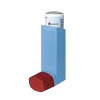Xopenex General Information

Xopenex is used to prevent and treat wheezing and shortness of breath caused by breathing problems (such as asthma, chronic obstructive pulmonary disease). It is a quick-relief drug. Xopenex belongs to a class of drugs known as bronchodilators. It works in the airways by opening breathing passages and relaxing muscles. Controlling symptoms of breathing problems can decrease time lost from work or school.
How to Use Xopenex
Read the Patient Information Leaflet provided by your pharmacist before you start using Xopenex and each time you get a refill. Follow the illustrated directions for the proper use of Xopenex and proper cleaning of the mouthpiece. If you have any questions, ask your doctor or pharmacist.
Shake the canister well before using. Follow the instructions for test sprays in the air if you are using a canister for the first time or if you have not used it for 3 days or more. A fine mist is a sign that the inhaler is working properly. Avoid spraying the medication in your eyes.
Inhale Xopenex by mouth as directed by your doctor, usually every 4 to 6 hours as needed. If two inhalations are prescribed, wait at least 1 minute between them. The dosage is based on your medical condition and response to treatment. Do not increase your dose or use Xopenex more often than prescribed without your doctor's approval. Using too much of Xopenex will increase your risk of serious (possibly fatal) side effects.
Using a spacer device with the inhaler may help you use Xopenex properly. Ask your doctor or pharmacist for more information.
If a child is using Xopenex, a parent or other responsible adult may need to help the child use the inhaler properly.
If you are using other inhalers at the same time, wait at least 1 minute between the use of each medication.
Always have this quick-relief inhaler with you. Keep track of the number of inhalations you use, and discard the inhaler after you have used the labeled number of inhalations on the product package. Also count test sprays used to prime the inhaler. Do not float the metal canister in water to test if any more drug is left in the canister.
Learn which of your inhalers you should use every day (controller drugs) and which you should use if your breathing suddenly worsens (quick-relief drugs). Ask your doctor ahead of time what you should do if you have new or worsening cough or shortness of breath, wheezing, increased sputum, worsening peak flow meter readings, waking up at night with trouble breathing, if you use your quick-relief inhaler more often (more than 2 days a week), or if your quick-relief inhaler does not seem to be working well. Learn when you can treat sudden breathing problems by yourself and when you must get medical help right away.
Tell your doctor if your symptoms do not improve or if they worsen.
Xopenex Possible Side Effects
Nervousness, dizziness, shaking (tremor), trouble sleeping, headache, nausea, dry mouth, cough, sore throat, or runny nose may occur. If any of these effects persist or worsen, tell your doctor or pharmacist promptly.
Remember that your doctor has prescribed Xopenex because he or she has judged that the benefit to you is greater than the risk of side effects. Many people using Xopenex do not have serious side effects.
Xopenex may raise your blood pressure. Check your blood pressure regularly and tell your doctor if the results are high.
Tell your doctor right away if you have any serious side effects, including: fast/pounding heartbeat.
Get medical help right away if you have any very serious side effects, including: chest pain, irregular heartbeat, rapid breathing, confusion.
Rarely, Xopenex has caused severe (rarely fatal), sudden worsening of breathing problems/asthma (paradoxical bronchospasm). If you experience sudden wheezing, get medical help right away.
A very serious allergic reaction to Xopenex is rare. However, get medical help right away if you notice any symptoms of a serious allergic reaction, including: rash, itching/swelling (especially of the face/tongue/throat), severe dizziness, trouble breathing.
Xopenex Precautions
Before taking Xopenex, tell your doctor or pharmacist if you are allergic to it; or to similar drugs (such as albuterol, metaproterenol, salmeterol); or if you have any other allergies. Xopenex may contain inactive ingredients, which can cause allergic reactions or other problems. Talk to your pharmacist for more details.
Before using Xopenex, tell your doctor or pharmacist your medical history, especially of: heart problems (such as irregular heartbeat, angina, previous heart attack), high blood pressure, kidney disease, seizure.
Xopenex may make you dizzy. Do not drive, use machinery, or do any activity that requires alertness until you are sure you can perform such activities safely. Limit alcoholic beverages.
Before having surgery, tell your doctor or dentist about all the products you use (including prescription drugs, nonprescription drugs, and herbal products).
During pregnancy, Xopenex should be used only when clearly needed. Discuss the risks and benefits with your doctor.
It is unknown if Xopenex passes into breast milk. Consult your doctor before breast-feeding.
Xopenex Possible Intercations
Drug interactions may change how your medications work or increase your risk for serious side effects. This document does not contain all possible drug interactions. Keep a list of all the products you use (including prescription/nonprescription drugs and herbal products) and share it with your doctor and pharmacist. Do not start, stop, or change the dosage of any medicines without your doctor's approval.
Xopenex is very similar to albuterol. Do not use inhaled medications containing albuterol while using Xopenex.